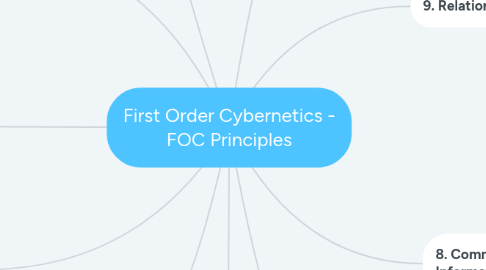First Order Cybernetics - FOC Principles
by Sam Van Der Ross


1. 3. Morphostasis and Morphogenesis
1.1. Morphostasis is the systems ability to remain stable in the context of change.
1.2. Morphogenesis is the systems enhanced behavior that allows for growth, creativity, innovation and change. All characteristics of a functional system.
2. 1. Recursion
2.1. People and events - mutual interaction and mutual influence
2.2. A is dependent on B as much as B is dependent on A - Behavioral Role - Sadist and Masochist
2.3. Without the one the other is meaningless
3. 2. Feedback (Positive and Negative
3.1. Aspect of recursion involving self correction
3.2. Feedback - Information about past behaviors is fed back into the system in a circular manner
3.3. Positive Feedback - Change has occurred and been accepted by the system
3.4. Negative Feedback - Status quo maintained
3.5. Goodness of feedback is relative to the context
4. 4. Rules and Boundaries
4.1. Rules express value of the system
4.2. Systems rules distinguish it from other systems
4.3. Rules form the boundaries of a system
4.4. Rules are unspoken and not overt
5. 5. Openness and Closedness
5.1. Extent to which system allows new information in and out of the system
5.2. Matter of degree - Families that have rigid boundaries tend to be more closed and families that have diffuse boundaries tend to be more open to change.
5.3. Appropriate balance = Healthy functioning
6. 6. Entropy and Negentropy
6.1. Too open or too closed - dysfunction
6.2. Entropy is maximum disorder
6.3. Negentropy is maximum order
7. 7. Equipotentiality and Equifinality
7.1. Balance between Openness/ Closedness, Morphogenesis/Morphostasis and Emtrpy/Negentropy the system can be best described in terms of either of the following:
7.2. Equifinality - final state from different initial points and in different ways based on dynamic interaction in an open system. Does not matter where you start the end result will always be the same. This is the redundant patterns of interaction.
7.3. Equifinality - Different end states can be arrived at from the same initial conditions.
8. 8. Communication and Information Processing
8.1. Principle 1: One cannot not behave
8.2. Principle 2: One cannot not communicate
8.3. Principle 3: People give meaning to behavior and it is not the same for everyone but for each individual person.
8.4. Congruent and Incongruent Communication
8.5. Avoiding Communication Traps
9. 9. Relationship and Wholeness
9.1. Two individuals that mutually influence one another.
9.2. The person is not considered as a person in isolation
9.3. Triangles is a two person dyad - relatively stable. When things are not stable a third person is brought into the relationship by one person.
9.4. Relationship Style
9.4.1. Complementary - High frequency of opposite kinds of behavior
9.4.2. Symmetrical - High frequency of the same behaviour
9.4.3. Parallel - Both complementary and symmetrical changes occur. Both members to accept responsibility and appropriateness.
